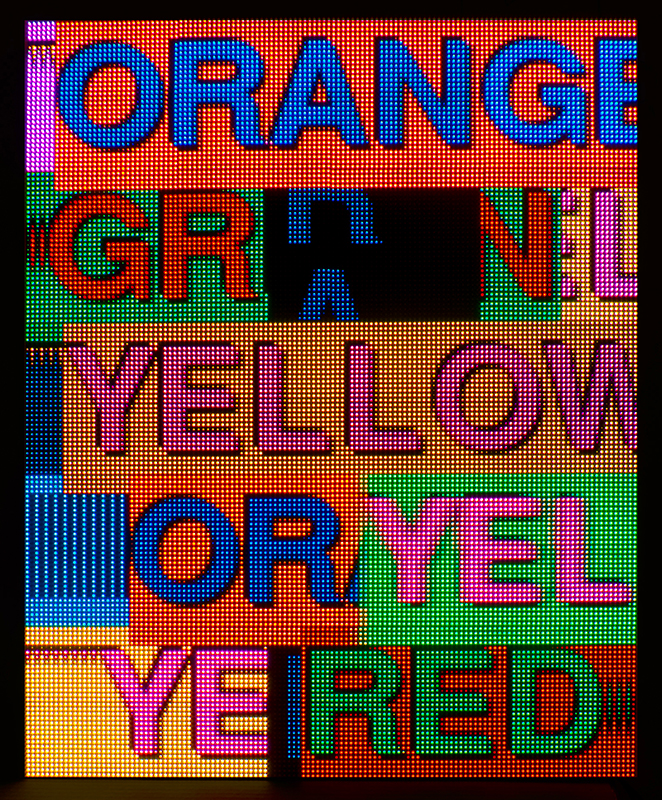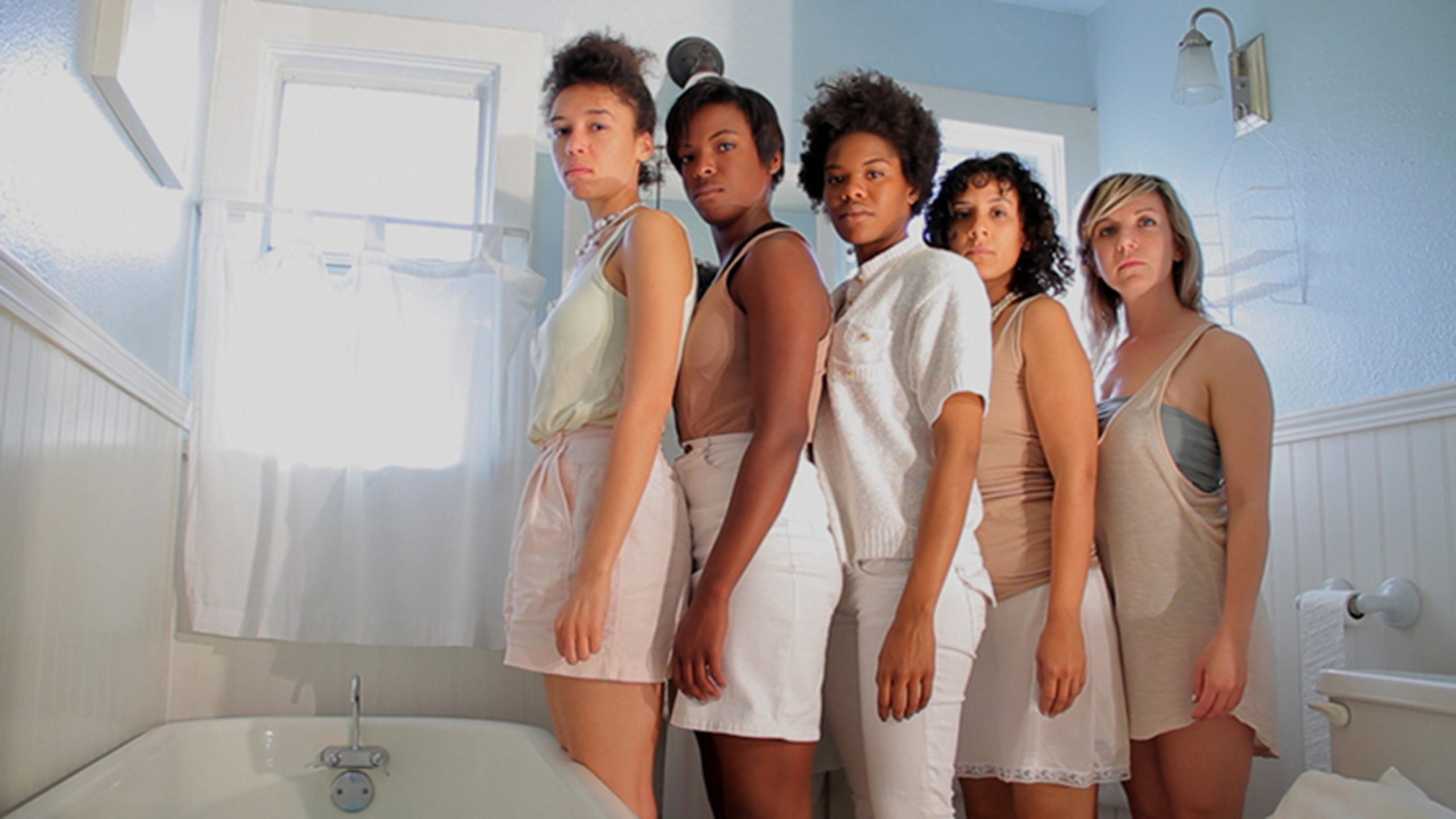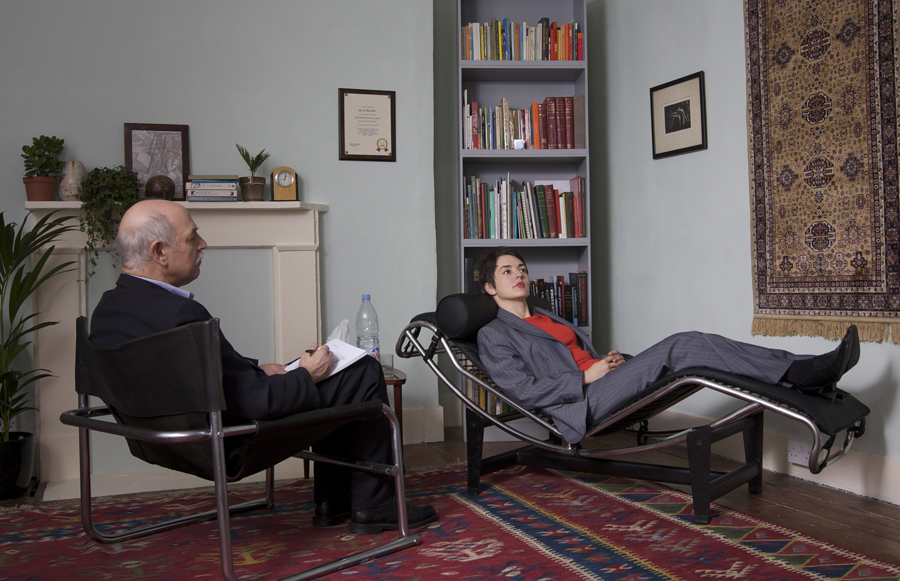
© » KADIST
Takeshi Murata
If one had been guessing at Takeshi Murata’s criticism of American consumerist culture up until watching Infinite Doors , it would be solidified after hearing the announcer from The Price is Right squawk prizes one after the next. In the two minutes of the film’s runtime, can count the word “new” used twenty-eight times, and “car”—the holy grail of prizes on that show—used eight times. The bodacious women introduce free prizes, the doors slide open repeatedly, and the crowd cheers with an insatiable appetite in a clear signal of an American propensity for numbing overconsumption.

© » KADIST
Danielle Dean
In 2003, Nike released a pair of red and black sneakers (the Dunk Low Pro SB ) that were marketed as “vampire” sneakers. Danielle Dean’s work True Red examines how a large corporation co-opted a historical fiction (the vampire), in addition to the traditional red and black colors of radical politics and the avant-garde. The animated video considers how capitalism can gentrify notions of radicality and the mutable nature of advertising.

© » KADIST
Luke Murphy
What Color is Luke Murphy’s outstanding digital painting that elegantly loops in nonstop motion. The artist cleverly usurped the familiar signage of brightly scrolling words that we ordinarily see calling out to advertise a Bodega or sidewalk cart’s fast food. In a DIY manner, Murphy constructed the extra-luminous LED panel screen and also wrote the code that sets the pace and pattern of the flowing words.

© » KADIST
Danielle Dean
Hexafluorosilicic acid is a type of sodium fluoride waste product that can be found in a large amount of widely available products such as cleaning fluids, toothpaste, rat poison, and drinking water. In Danielle Dean’s video Hexafluorosilicic , she mulls on this substance and its troubling co-option by modern society. In an indistinct US city, in an empty apartment, three characters (one of whom, unusually for Dean, is a white male) all wear brightly colored medical scrubs and undertake seemingly trivial and nonsensical experiments.

© » KADIST
Danielle Dean
No Lye by Danielle Dean documents a group of five women, including Dean herself, confined to a small, cramped bathroom, communicating only by using slogans culled from beauty advertisements (“beauty is skin deep”, “naturalise, it’s in our nature to be strong and balanced”) and quotes from political speeches (“we must protect our borders”, “we are fighting for our way of life and our ability to fight for freedom”). The result is a fragmented conversation that defies legibility. As sounds of a possible conflict rise from outside, the characters work together producing what looks like explosives from soap, towels, and an unmarked blue liquid.

© » KADIST
Laetitia Sonami
Although at first the work Sounds of War presents itself with a degree of playfulness and humour, a close inspection reveals its painful undertone. The sound installation by Laetitia Sonami is comprised by a series of toilet plungers retrofitted with speakers that audiences are encouraged to engage with. As viewers interact with the modified domestic objects, placing them over their ears, a soundtrack plays audio sourced by the artist from Youtube videos, which feature the haunting voices of women and children in several war zones (Srebrenica, Darfur, Fallujah, Gaza and Iraq).

© » KADIST
Jibade-Khalil Huffman
Jibade-Khalil Huffman’s work brings together spoken and written language, photography, vintage television and computer animation to pay homage to African-American popular culture. Figuration (B) is a mediatic dumpster dive through the not-yet-historical past, its fantasia of purloined images flowing to an interruptive, channel-surfing logic. A stream of TV clips, commercials, news segments, video memes, and movie scenes—at times run backwards, doubled, or layered over other clips—incorporate archival and pop cultural sources layered with a soundtrack constructed of found and made sources to make something akin to a video mixtape.

© » KADIST
Collier Schorr
In the Collage II (Marie) (2013), Shorr seems to have an ostensibly clear subject, a female subject identified in the work’s title as “Marie,” a slim but athletic woman with brown hair pictured reclining atop a brilliantly white sheet draped against a marbled tan-and-white backdrop. Although photographed topless, Marie is depicted in slightly contorted poses that emphasize the curves of her figure while also obstructing the viewer’s gaze. Printed on high gloss paper, Marie’s portrait has the polished veneer of magazine spread, and the two portraits on display offer different vantages of the same subject.

© » KADIST
LaToya Ruby Frazier
LaToya Ruby Frazier is an artist and a militant; her photos combine intimate views of her relation with her parents and grandparents with the history of the Afro-American community of Braddock, Pennsylvania, where she grew up and where her family still live. She reports upon the decline of this steel-producing town, which was once prosperous and where the local population today is devastated by poverty, unemployment and health problems linked to pollution. The town has currently closed the hospital which increases unemployment and makes access to treatment complicated for the residents of one of the most polluted towns in the USA.

© » KADIST
Carey Young
“Product Recall” is a video perfomative pun on the action recalling memories in the form of a psychoanalytic session and the recall of faulty products from multinational corporations. Young enters a practicing psychoanalyst room and begins a session. Dressed in corporate business attire, Young encompasses both the corporation and individual.

© » KADIST
Hank Willis Thomas
South Africa Righteous Space by Hank Willis Thomas is concerned with history and identity, with the way race and ‘blackness’ has not only been informed but deliberately shaped and constructed by various forces – first through colonialism and slavery, and more recently through mass media and advertising – and reminds us of the financial and economic stakes that have always been involved in representations of race.
Danielle Dean
Danielle Dean creates videos that use appropriated language from archives of advertisements, political speeches, newscasts, and pop culture to create dialogues to investigate capitalism, post-colonialism, and patriarchy...
Laetitia Sonami
Based in San Francisco, Laetitia Sonami is a French-born electronic composer, performer, sound installation artist and educator...
LaToya Ruby Frazier
LaToya Ruby Frazier was born in 1982 in Braddock, Pennsylvania (USA)...
Jibade-Khalil Huffman
Jibade-Khalil Huffman uses performance, photography, and video that pushes the capabilities of text and image to tell stories and convey meaning...
Carey Young
- location: Lusaka, Zambia
- year born: 1970
- gender: female
- nationality: Zambian
Luke Murphy
Luke Murphy is a systems-based artist whose work is loosely bound by common themes of quantifying elements of the psyche and spirit with a particular interest in the Gnostic gospels, religious paintings, and digital languages – codes and systems to make art...
Hank Willis Thomas
- location: New York, New York
- year born: 1976
- gender: male
- nationality: American
- home town: Plainfield, New Jersey
Takeshi Murata
Underlining the temporality of nostalgia, memory, and narratives crafted through cinematic pop culture, the American artist Takeshi Murata has constructed a body of animated works that explore the lifespan of moving images and their role in the shaping of shared cultural histories...
-
2000-2009
Laetitia Sonami
2006Although at first the work Sounds of War presents itself with a degree of playfulness and humour, a close inspection reveals its painful undertone...
Carey Young
2007“Product Recall” is a video perfomative pun on the action recalling memories in the form of a psychoanalytic session and the recall of faulty products from multinational corporations...
-
2010-2019
Takeshi Murata
2010If one had been guessing at Takeshi Murata’s criticism of American consumerist culture up until watching Infinite Doors , it would be solidified after hearing the announcer from The Price is Right squawk prizes one after the next...
LaToya Ruby Frazier
2011LaToya Ruby Frazier is an artist and a militant; her photos combine intimate views of her relation with her parents and grandparents with the history of the Afro-American community of Braddock, Pennsylvania, where she grew up and where her family still live...
Danielle Dean
2012No Lye by Danielle Dean documents a group of five women, including Dean herself, confined to a small, cramped bathroom, communicating only by using slogans culled from beauty advertisements (“beauty is skin deep”, “naturalise, it’s in our nature to be strong and balanced”) and quotes from political speeches (“we must protect our borders”, “we are fighting for our way of life and our ability to fight for freedom”)...
Collier Schorr
2013In the Collage II (Marie) (2013), Shorr seems to have an ostensibly clear subject, a female subject identified in the work’s title as “Marie,” a slim but athletic woman with brown hair pictured reclining atop a brilliantly white sheet draped against a marbled tan-and-white backdrop...
Hank Willis Thomas
2014South Africa Righteous Space by Hank Willis Thomas is concerned with history and identity, with the way race and ‘blackness’ has not only been informed but deliberately shaped and constructed by various forces – first through colonialism and slavery, and more recently through mass media and advertising – and reminds us of the financial and economic stakes that have always been involved in representations of race....
Danielle Dean
2015Hexafluorosilicic acid is a type of sodium fluoride waste product that can be found in a large amount of widely available products such as cleaning fluids, toothpaste, rat poison, and drinking water...
Danielle Dean
2016In 2003, Nike released a pair of red and black sneakers (the Dunk Low Pro SB ) that were marketed as “vampire” sneakers...
Luke Murphy
2016What Color is Luke Murphy’s outstanding digital painting that elegantly loops in nonstop motion...
Jibade-Khalil Huffman
2017Jibade-Khalil Huffman’s work brings together spoken and written language, photography, vintage television and computer animation to pay homage to African-American popular culture...

